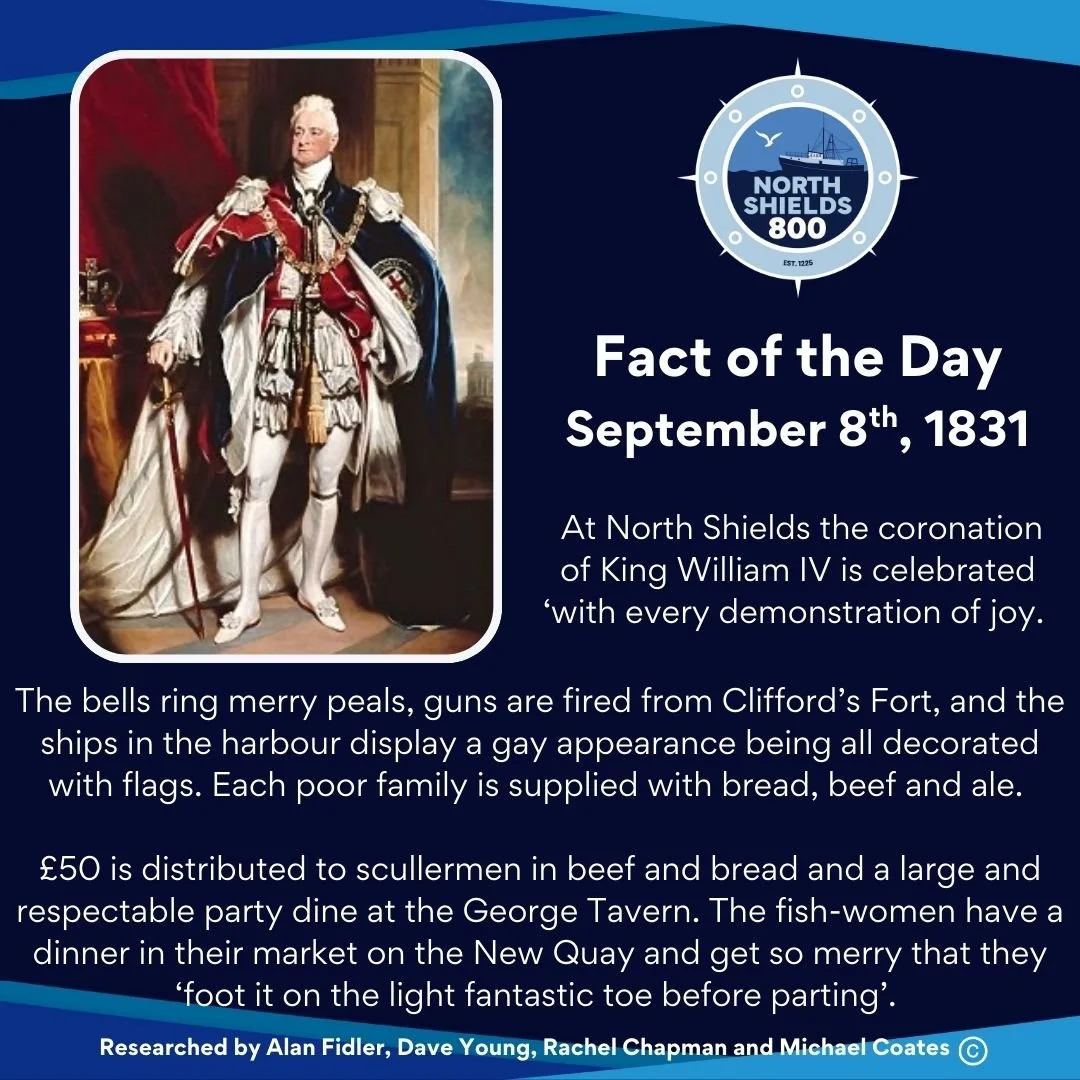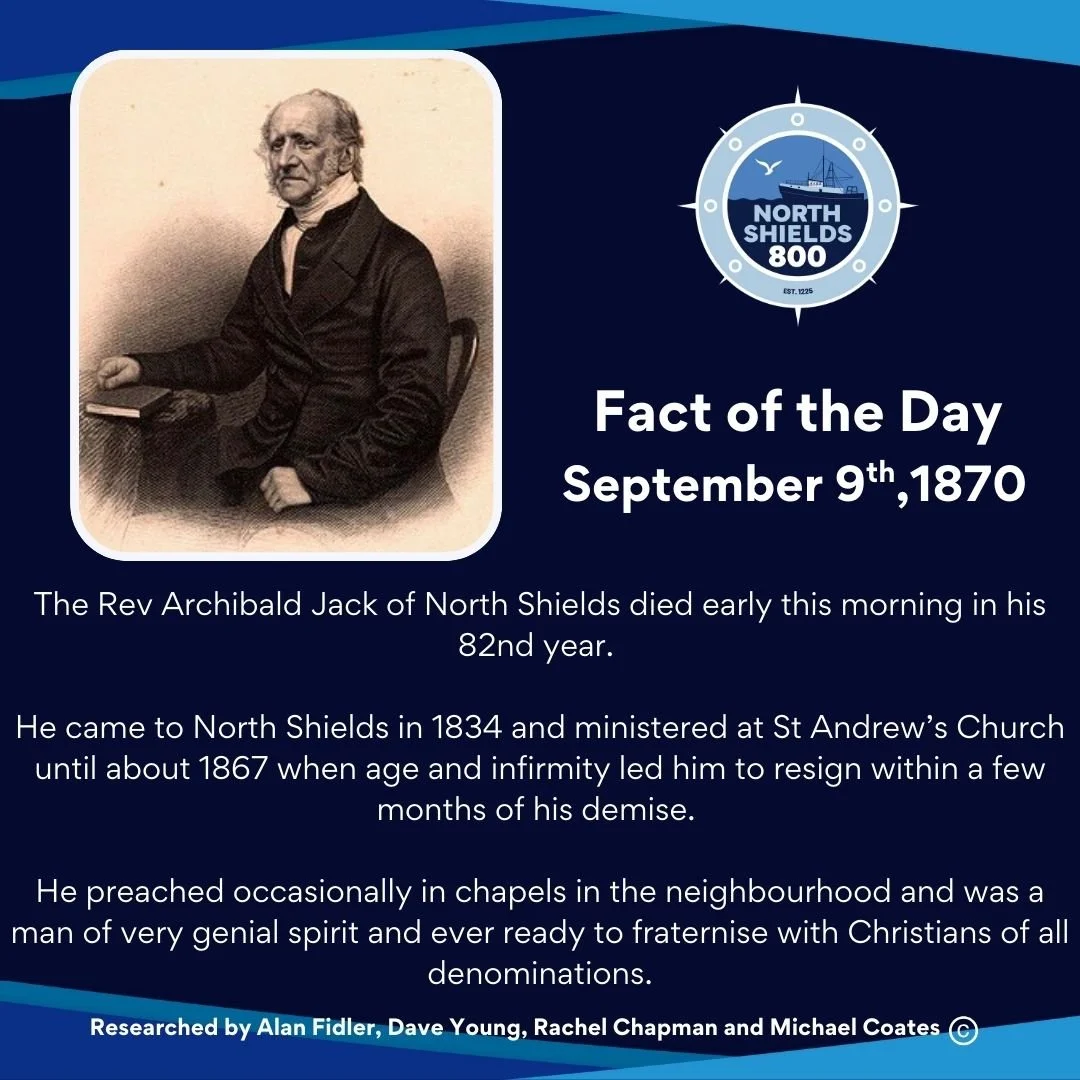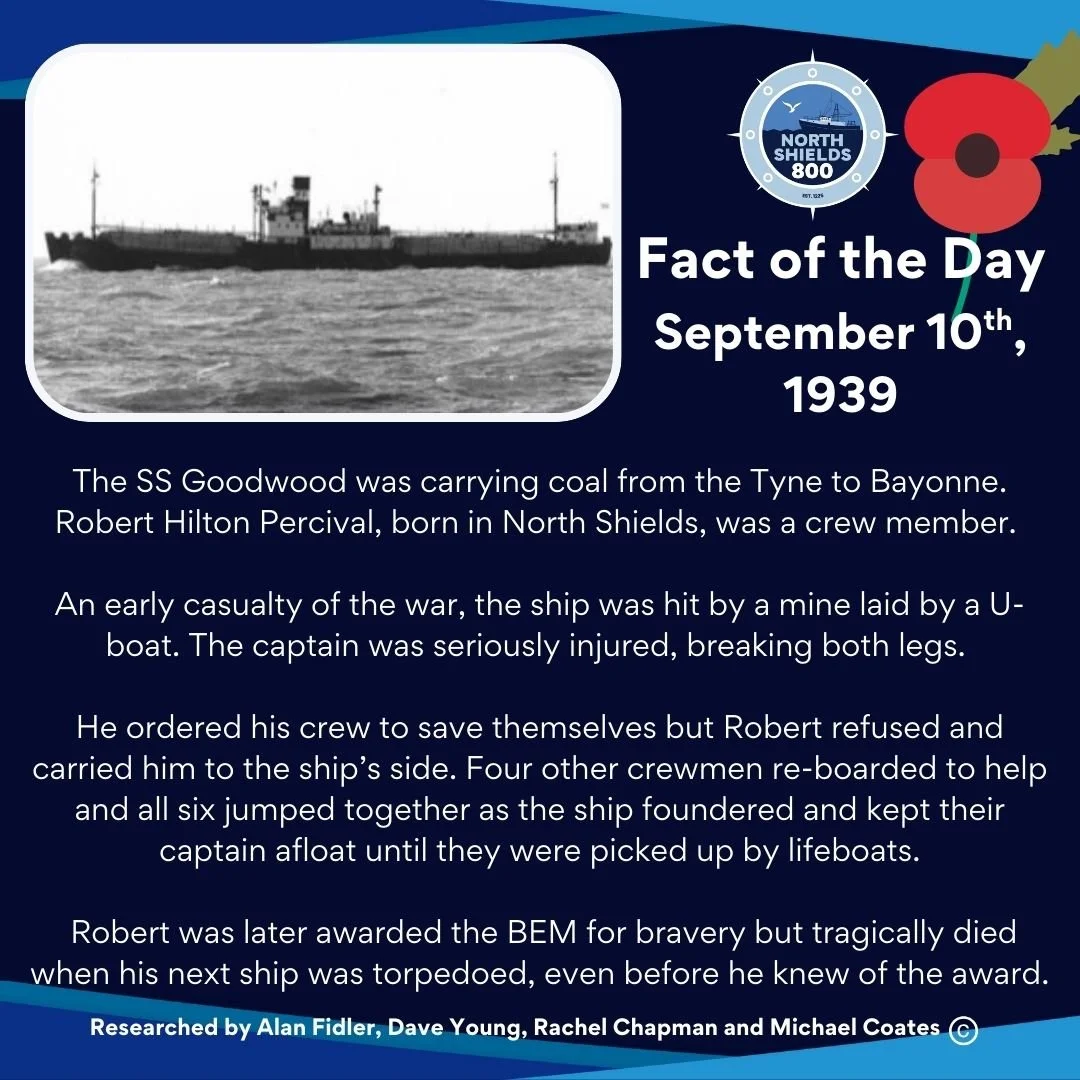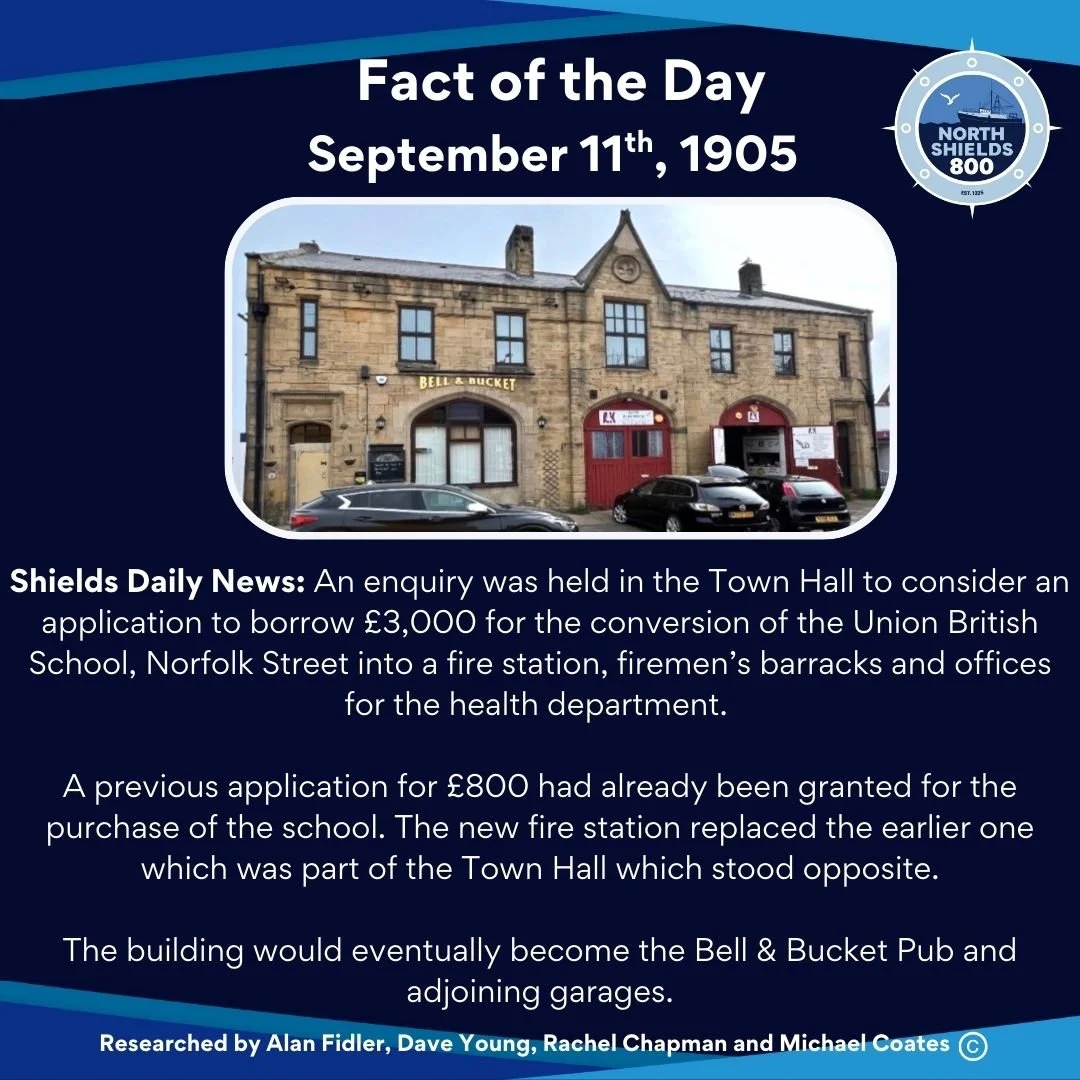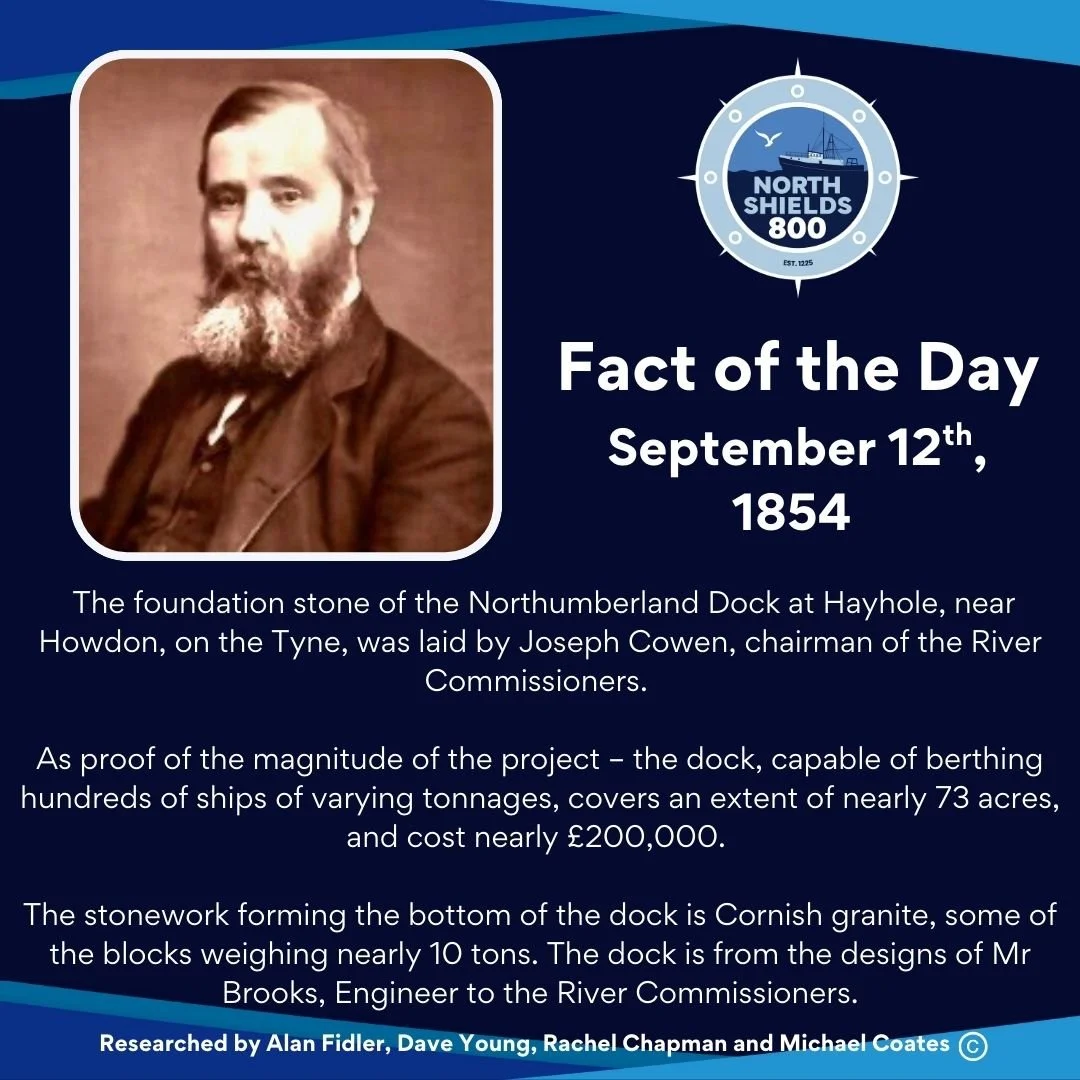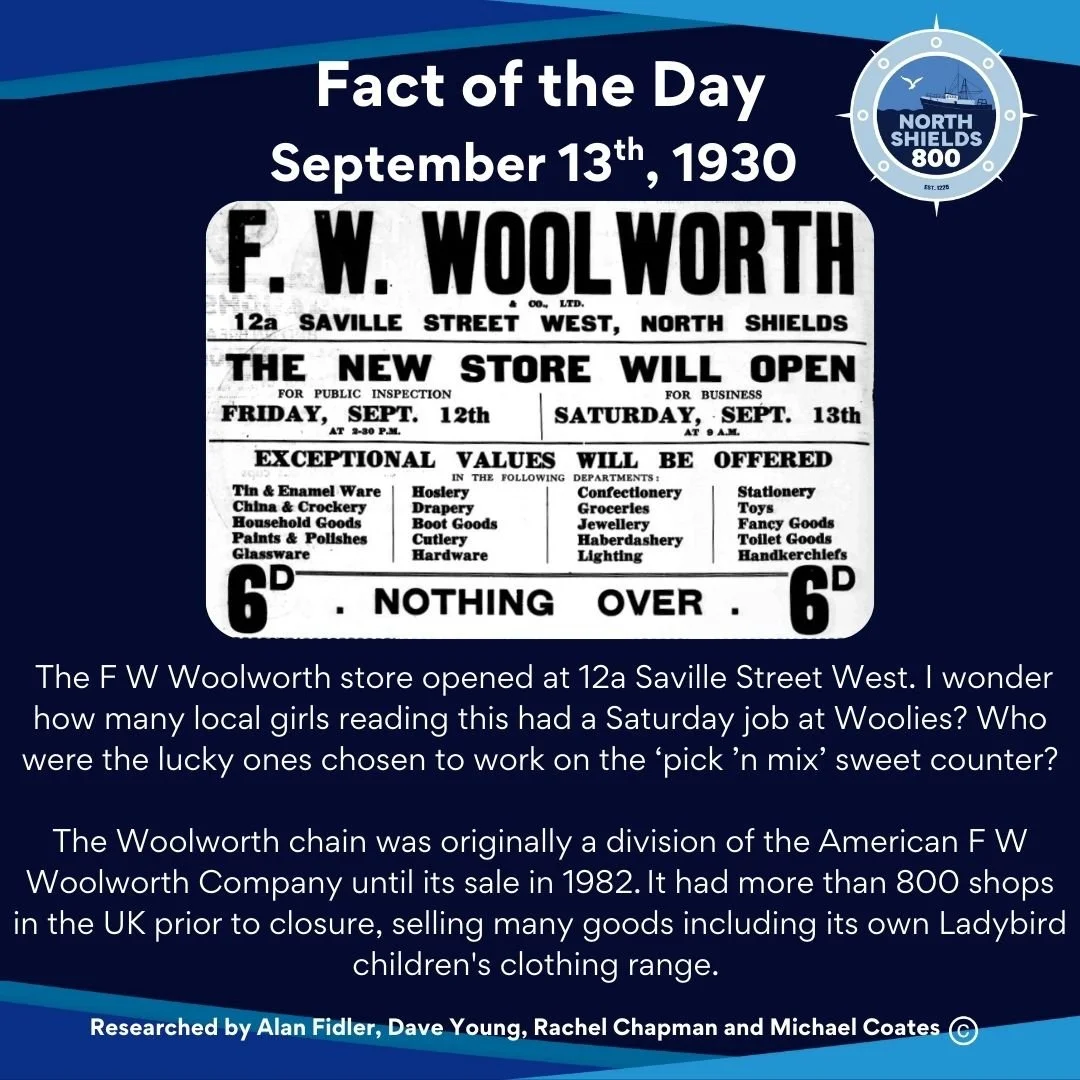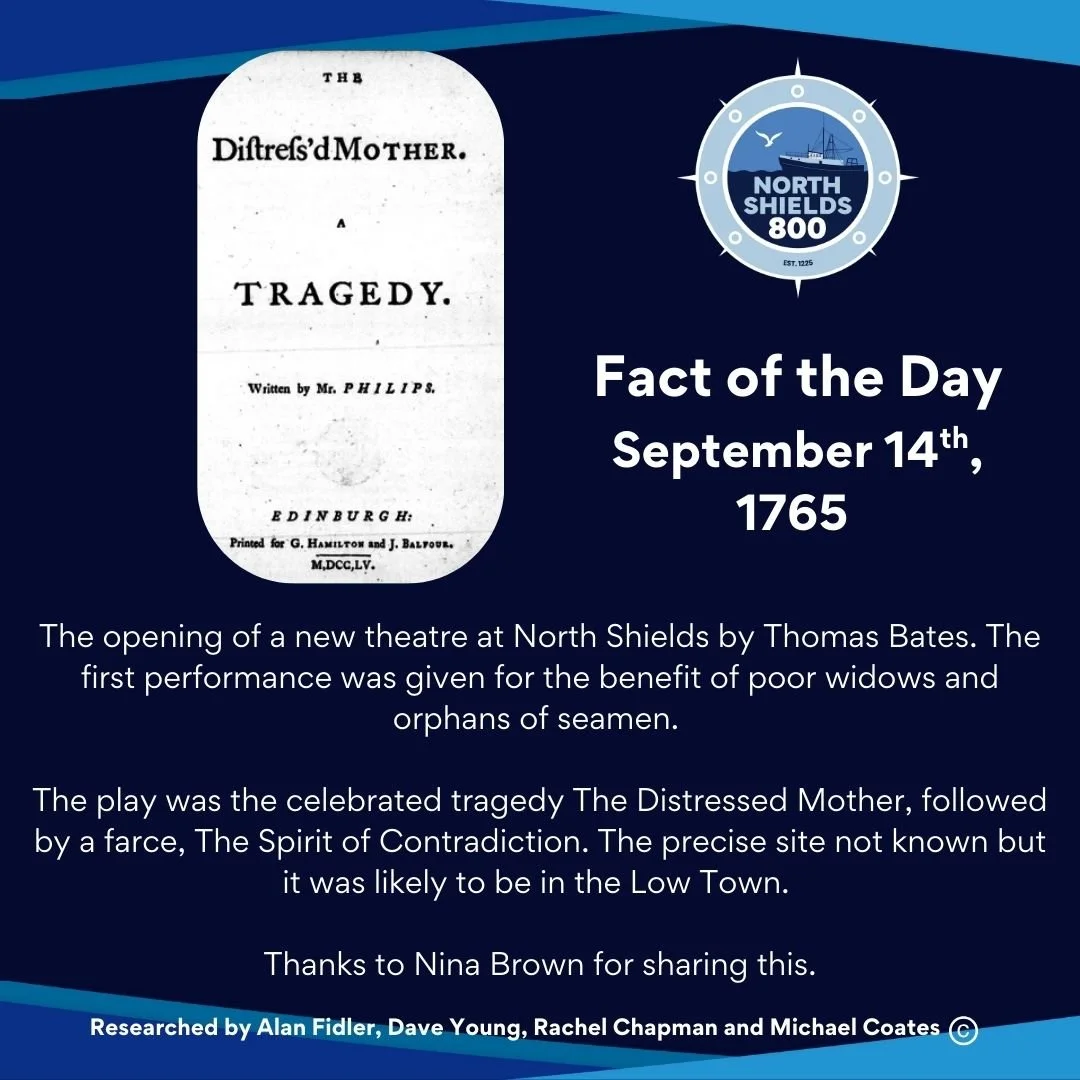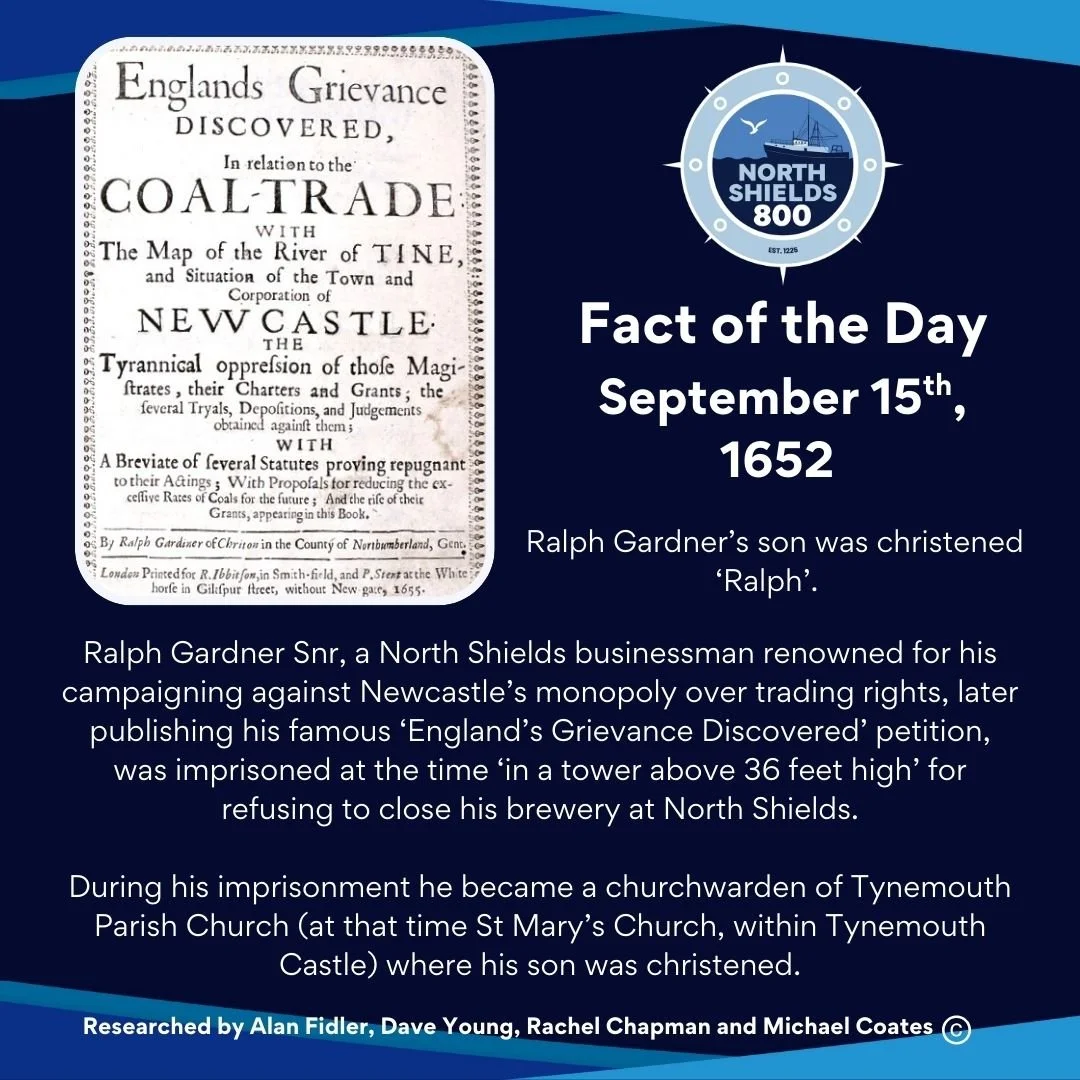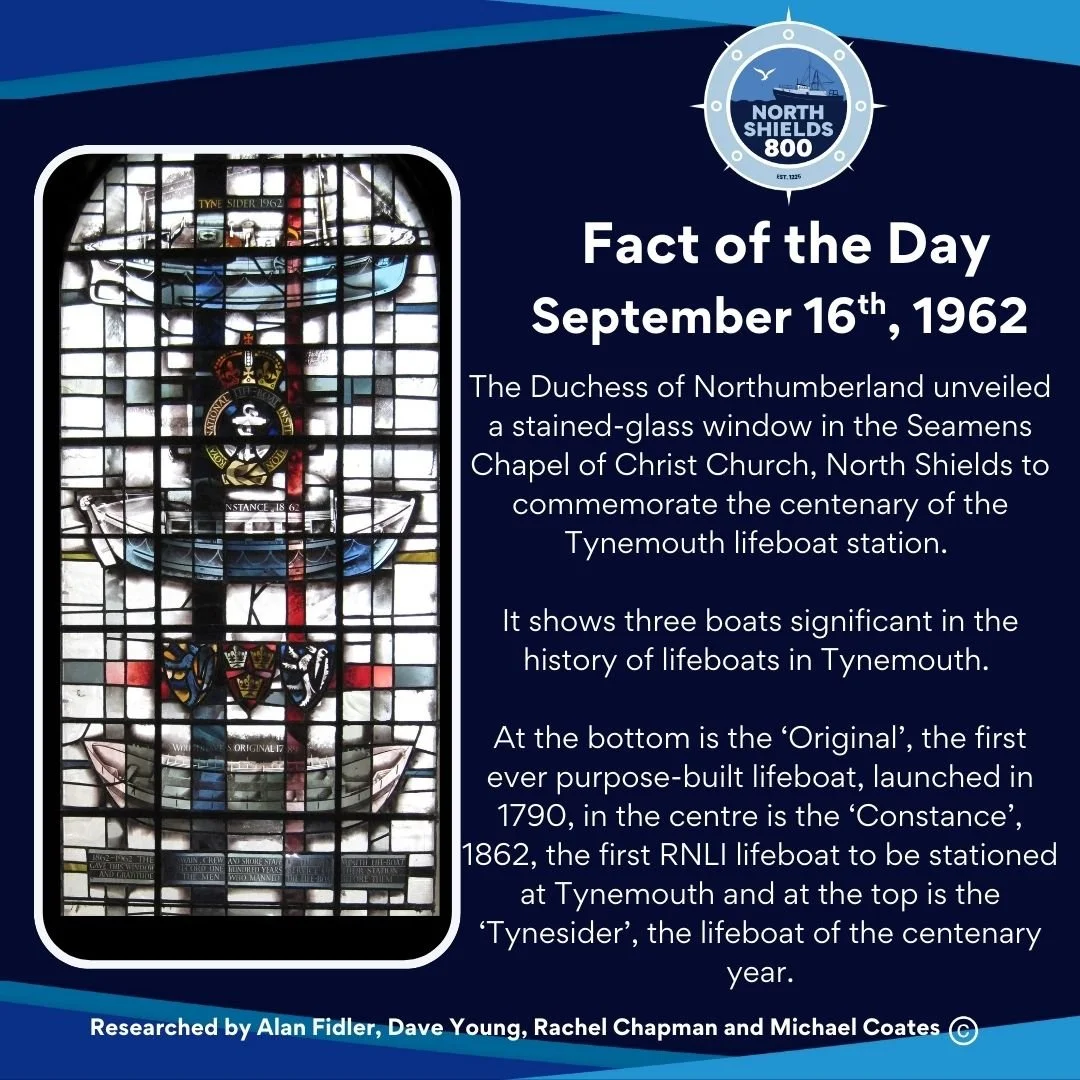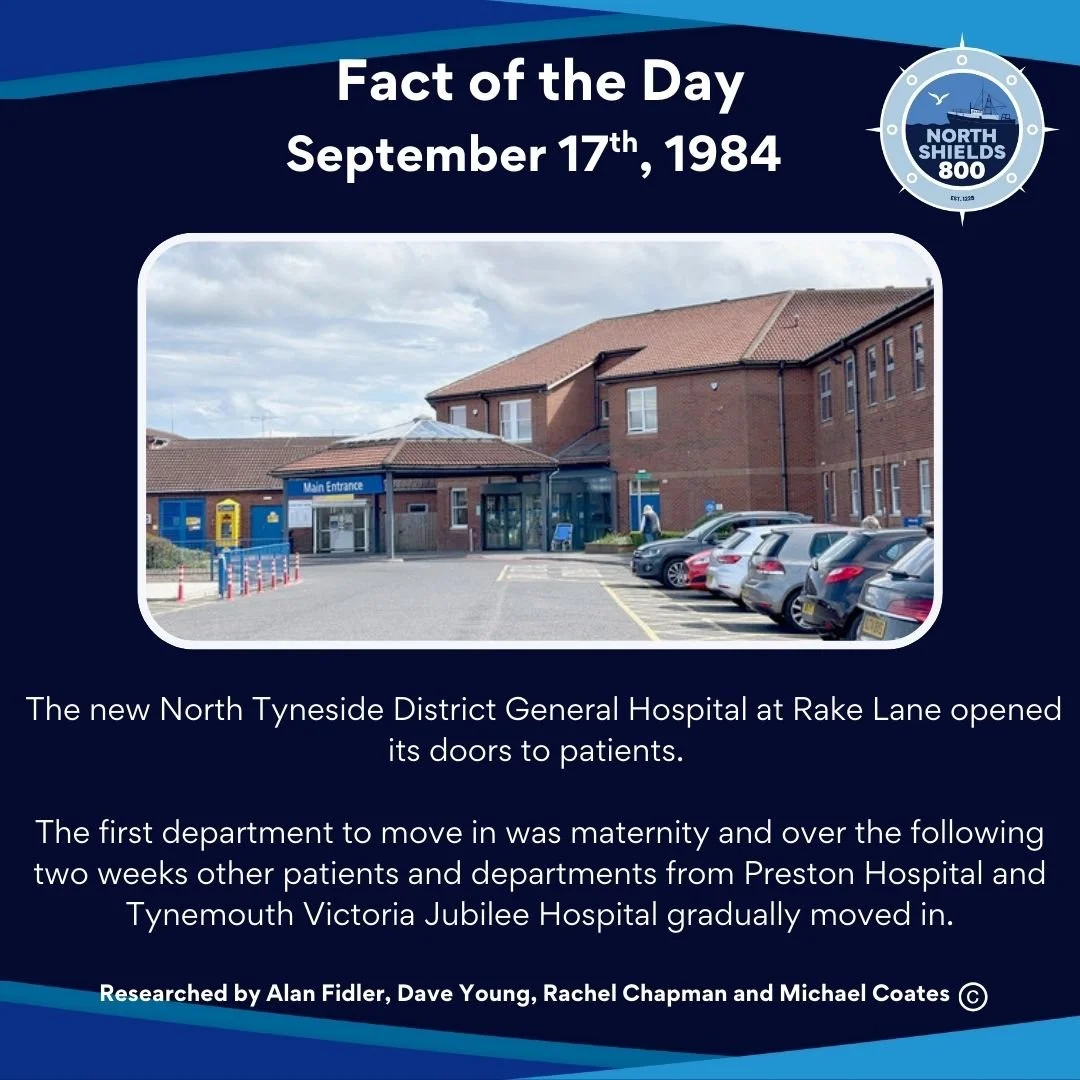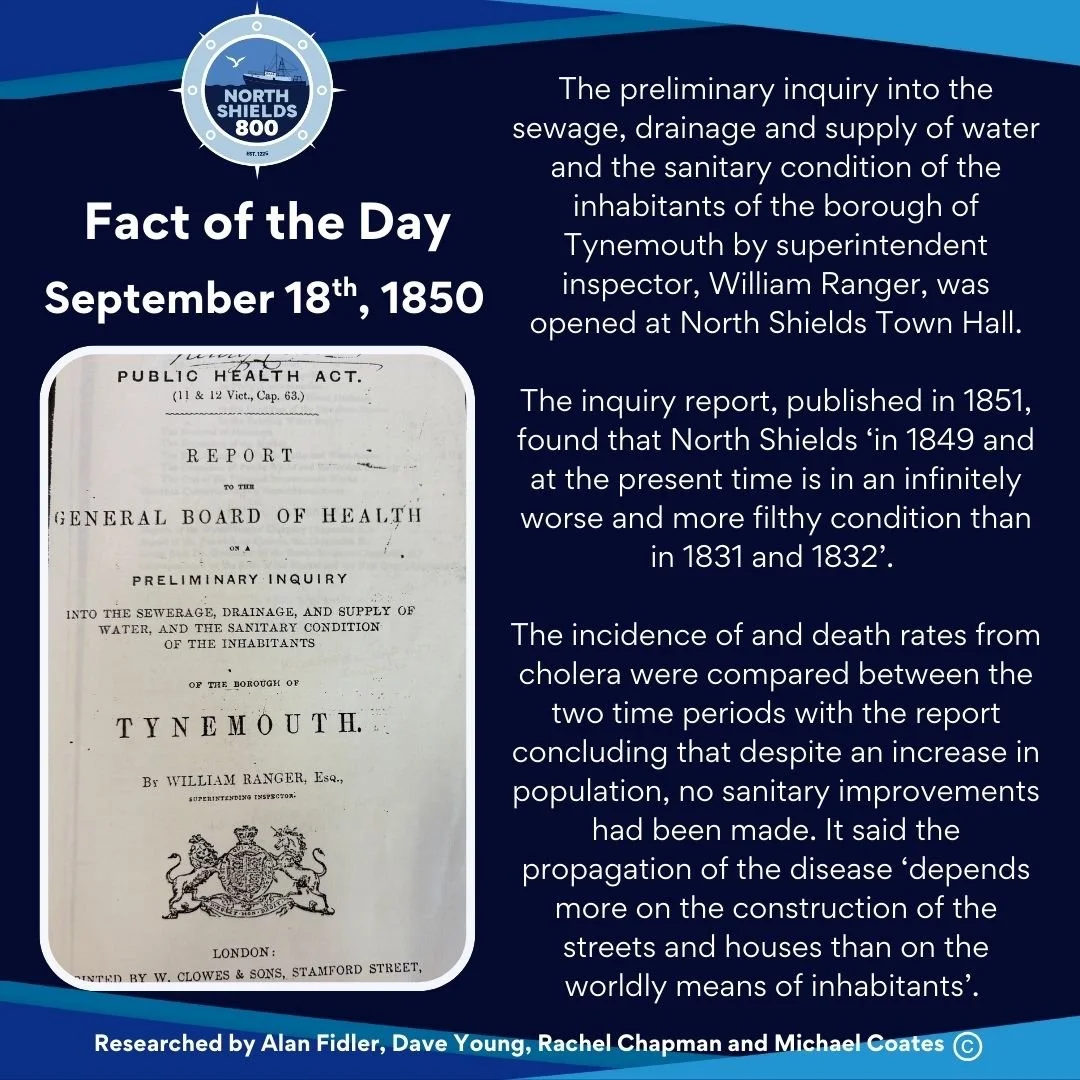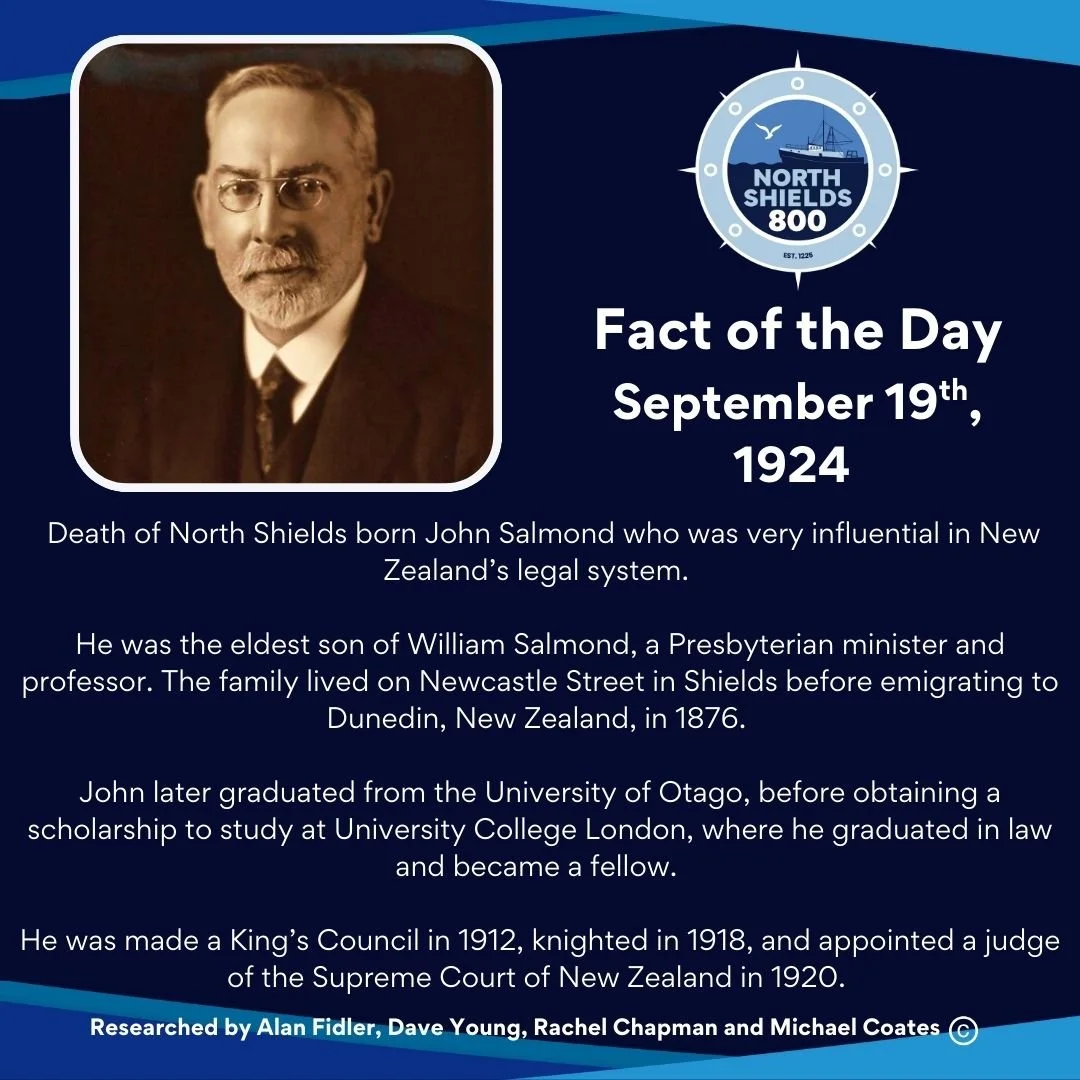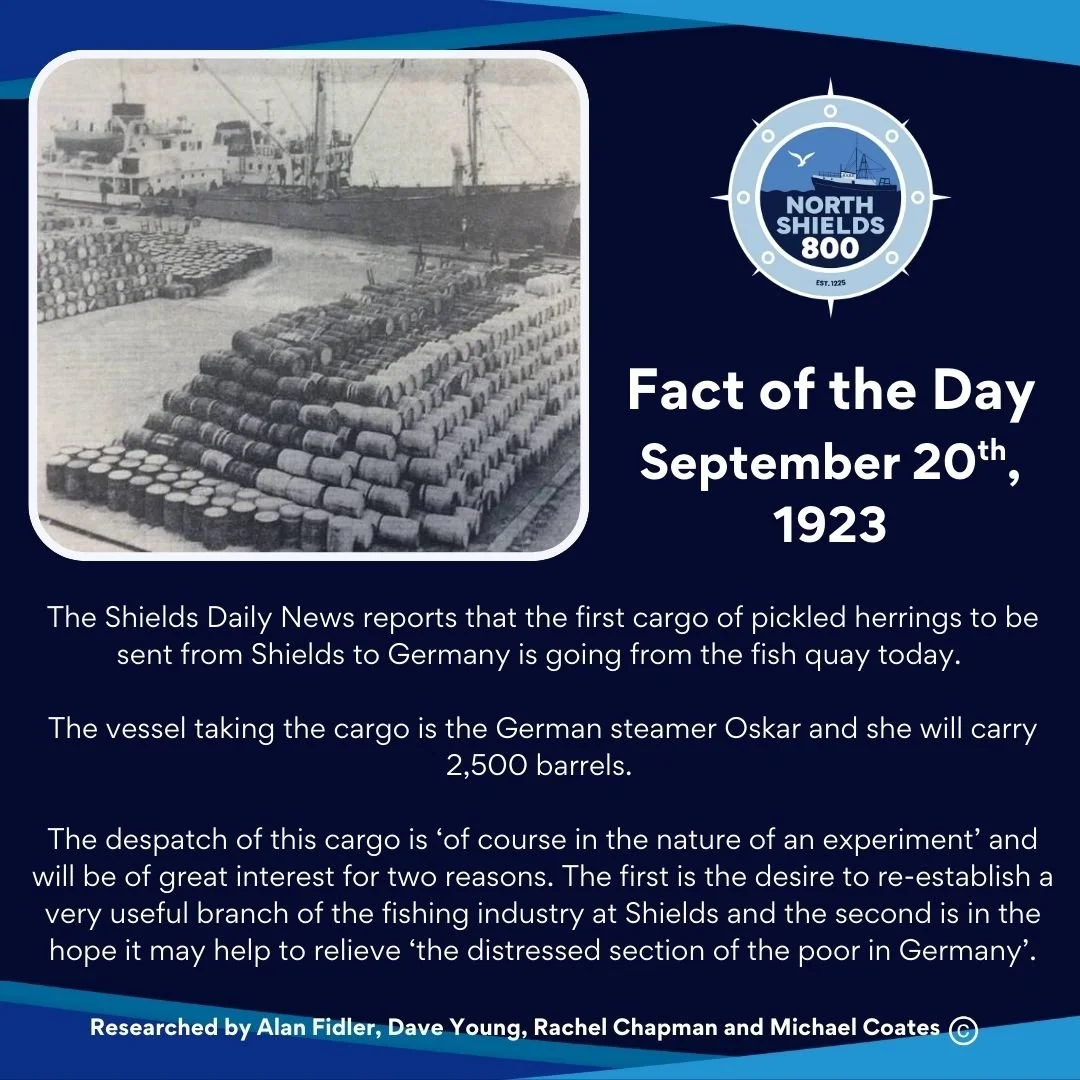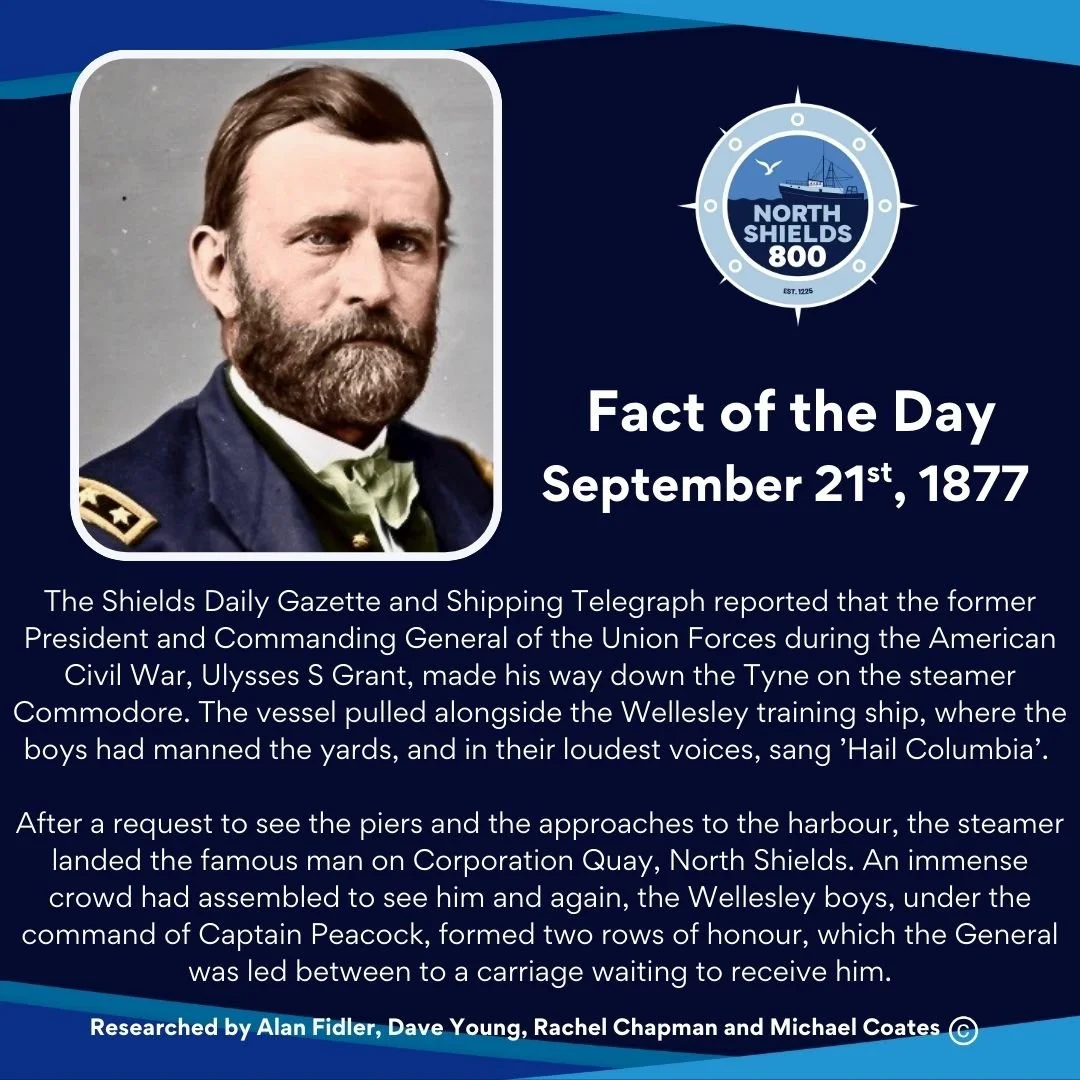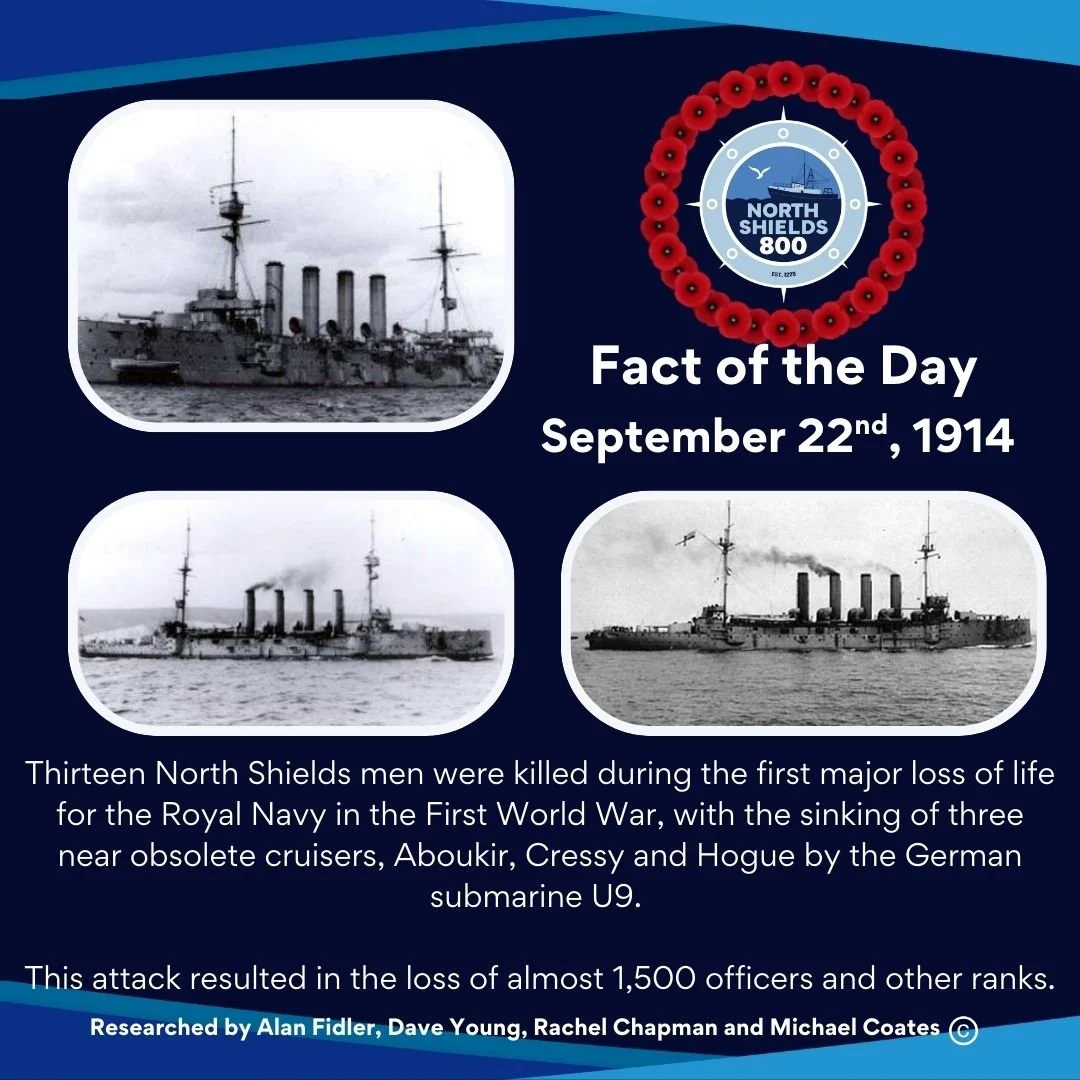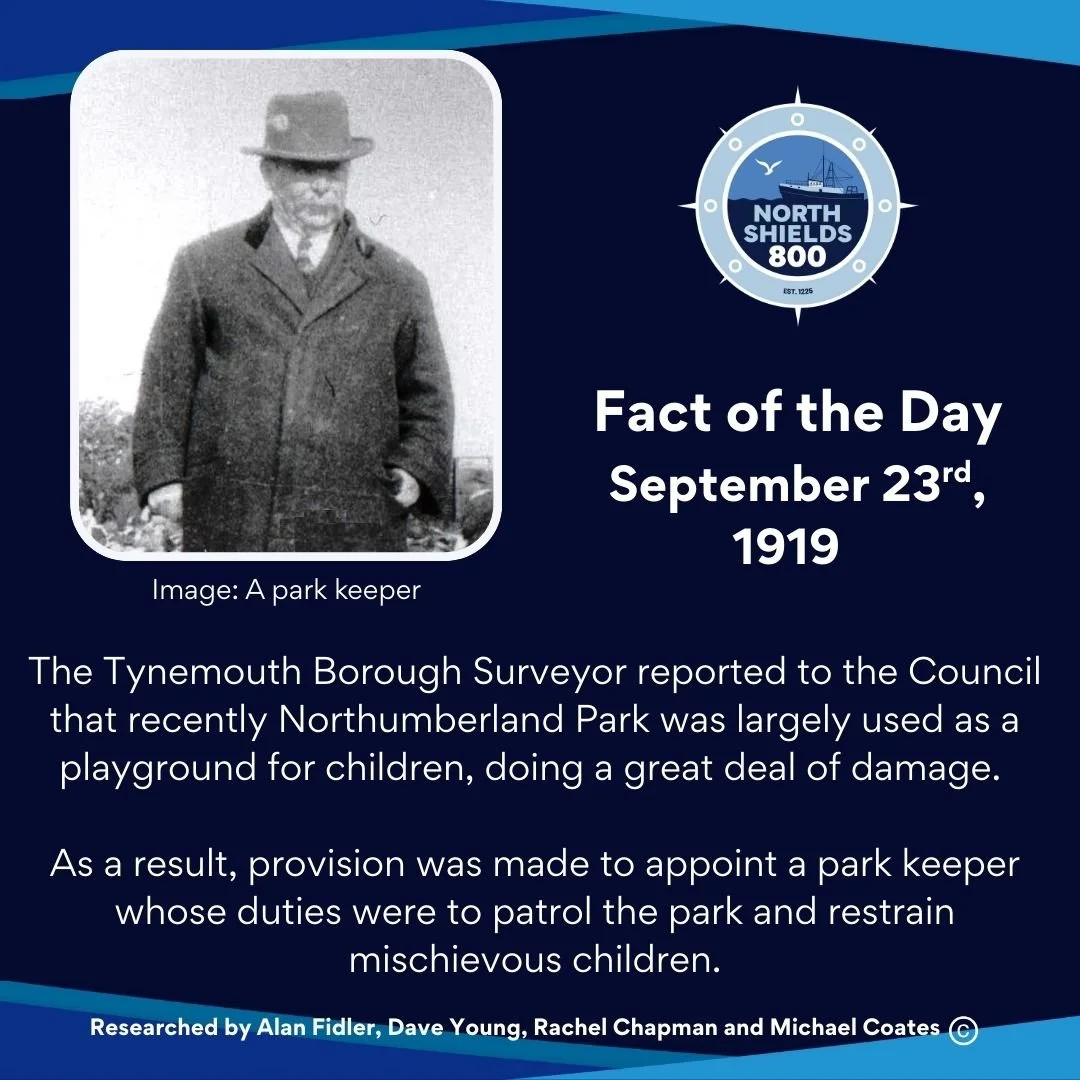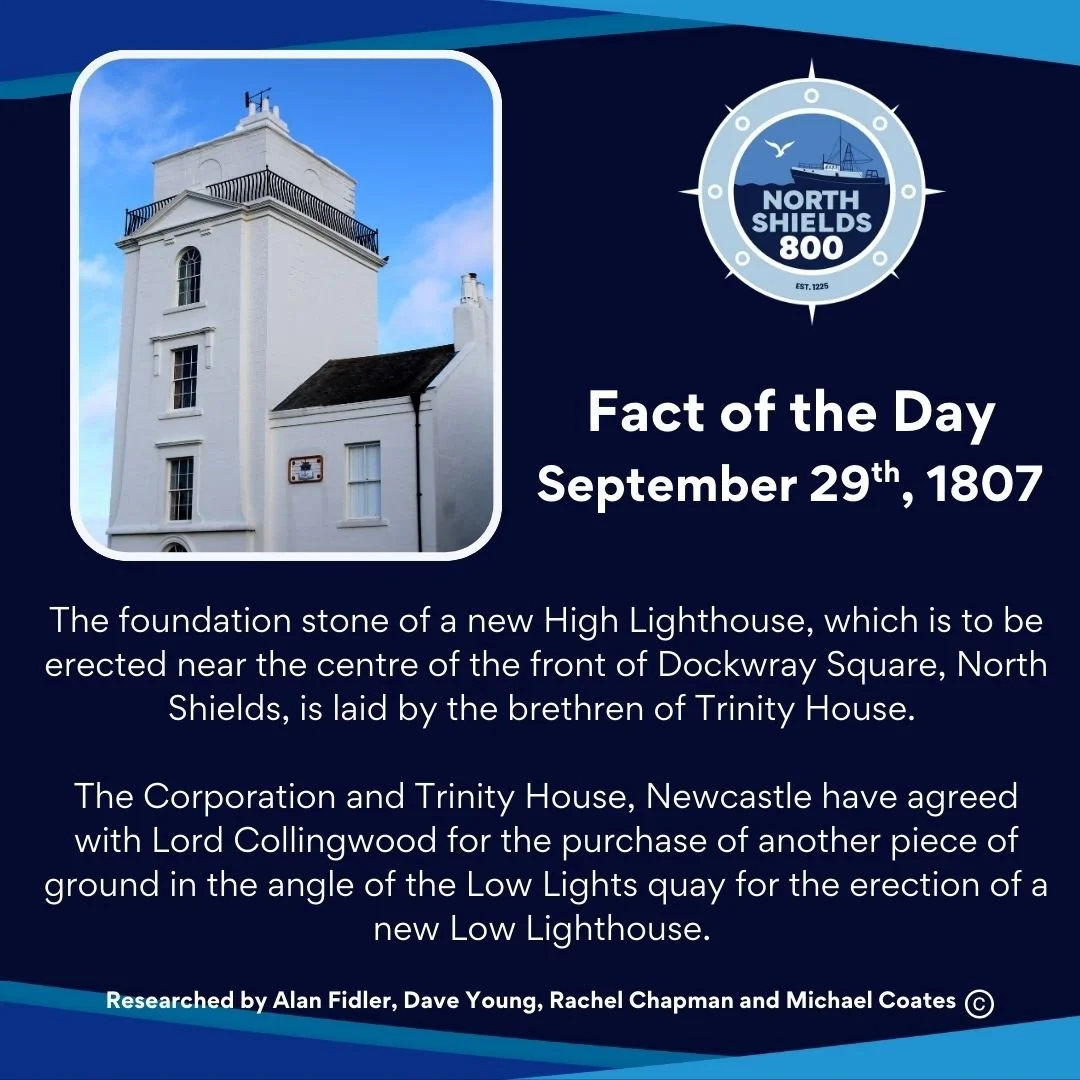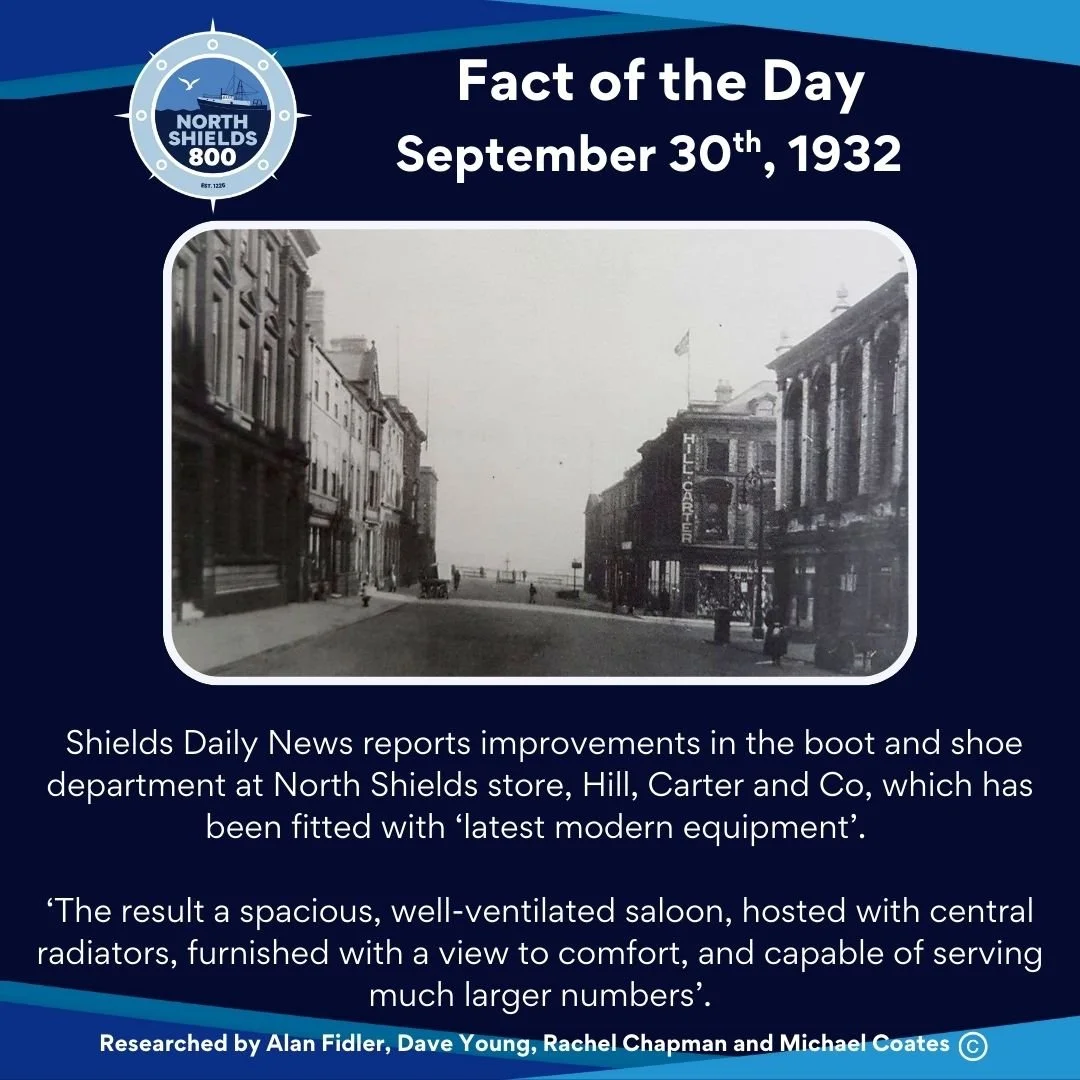Fact of the Day - September
All of September’s North Shields 800 Facts of the Day in one place.
September 1st, 1826
A public notice was displayed advising local people that the trustees of the school endowed by the late Thomas Kettlewell were now ready to receive applications, with preference being given to ‘orphans and fatherless children’.
Thomas Kettlewell of Walker Place, North Shields, was a sailmaker who began a business at North Shields with a capital of £37 and built up a big enough fortune to ‘indulge his liking for philanthropy’.
In 1819 he set aside land at the corner of George Street and Upper Toll Street for the building of a school, leaving most of his fortune when he died in 1824 to bring this to fruition.
September 2nd, 1838
The boiler of the steam tug Vivid belonging to a family named Greener of North Shields exploded in the Tyne.
Two young men, sons of the owner, were dreadfully scalded and died shortly after in great agony.
September 3rd, 1953
An old baptismal register was found under the organ at Salem Methodist Church, Linskill Street which recorded the baptisms of two brothers and a sister of Sir James Knott from the time when the family lived in that street.
Trustees of The Knott Charitable Trust were informed about the find and donated £500 towards the church alterations.
Salem Methodist Church was the oldest Free Church in North Shields, its foundations having been laid on New Year’s Day 1836.
September 4th, 1916
Two North Shields brothers William and Edwin Brown, serving in the Norfolk Regiment, were killed in action in France.
Their commanding officer wrote to their mother: "It is with the deepest regret that I write to tell you that your two sons, William John Henry and Edwin Percival, were killed in action during the attack on Falfemont Farm on 4th Sept. Both were excellent officers, and they are a great loss to us, and the whole regiment feel with you most deeply in your great loss. Both were leading their men with great gallantry in the attack and were killed instantaneously.”
Blue plaques were placed on the family home in Northumberland Square by the Northumbria World War One Commemoration Project.
September 5th, 1950
The Evening News: After 50 years' service on Tyne tugboats, 37 years as skipper, Mr Robert Hunter, of Chirton Lane, North Shields, retired.
Among the best-known figures in Tyne shipping circles, Mr Hunter was in command of the powerful tugboat George V, the rescue tug for the Tyne area during the last war and towed 42 disabled vessels which had either been bombed, torpedoed or damaged in collision.
He joined the firm of Redhead and Son, Newcastle, in 1911 as mate of the first tug George V, and two years later took over command.
September 6th, 1902
The Shields Daily News carried an advert noting that language classes from Monsieur V. Mauboussin and Madame Mauboussin have now opened for ‘Ladies, Gentlemen and Children’, terms on application from 5 Coburg Terrace, North Shields. They also had premises on Howard Street.
The Mauboussins held a ‘French Soiree’ each year hosted by a local dignitary and assisted by friends. The event would be attended by up to 400 people at venues in both North Shields and Tynemouth. The evening would include music performed in French by local residents, always concluding with the singing of ‘God Save the King’ and ‘La Marseillaise’.
September 7th, 1874
Thomas Eustace Smith, MP for Tynemouth & North Shields, laid the foundation stone of a new Temperance church in Stephenson Street, which a few years later became a Congregational Church. He spoke warmly of ecumenism, at a gathering of 1,000 people. The church was built by Joseph Elliott and opened in May 1875.
Stephenson Street Church began with the temperance campaign of the Wesleyan preacher, John Broadbent, at first from the steps of the library in Howard Street. Evidently Broadbent’s style was not to the liking of the existing Methodist establishment. In September 1870 the congregation met and re-formed itself as the “Evangelistic Temperance Church” and called the Rev Harry Vian Williams as its first minister, the entire congregation meeting him at North Shields railway station with hymn-singing.
September 8th, 1831
At North Shields the coronation of King William IV is celebrated ‘with every demonstration of joy.
The bells ring merry peals, guns are fired from Clifford’s Fort, and the ships in the harbour display a gay appearance being all decorated with flags.
Each poor family is supplied with bread, beef and ale. £50 is distributed to scullermen in beef and bread and a large and respectable party dine at the George Tavern.
The fish-women have a dinner in their market on the New Quay and get so merry that they foot it on the light fantastic toe before parting’.
September 9th, 1870
The Rev Archibald Jack of North Shields died early this morning in his 82nd year.
He came to North Shields in 1834 and ministered at St Andrew’s Church until about 1867 when age and infirmity led him to resign within a few months of his demise.
He preached occasionally in chapels in the neighbourhood and was a man of very genial spirit and ever ready to fraternise with Christians of all denominations.
September 10th, 1939
The SS Goodwood was carrying coal from the Tyne to Bayonne. Robert Hilton Percival, born in North Shields, was a crew member.
An early casualty of the war, the ship was hit by a mine laid by a U-boat. The captain was seriously injured, breaking both legs.
He ordered his crew to save themselves but Robert refused and carried him to the ship’s side. Four other crewmen re-boarded to help and all six jumped together as the ship foundered and kept their captain afloat until they were picked up by lifeboats.
Robert was later awarded the BEM for bravery but tragically died when his next ship was torpedoed, even before he knew of the award.
September 11th, 1905
Shields Daily News: An enquiry was held in the Town Hall to consider an application to borrow £3,000 for the conversion of the Union British School, Norfolk Street into a fire station, firemen’s barracks and offices for the health department.
A previous application for £800 had already been granted for the purchase of the school. The new fire station replaced the earlier one which was part of the Town Hall which stood opposite.
The building would eventually become the Bell & Bucket Pub and adjoining garages.
September 12th, 1854
The foundation stone of the Northumberland Dock at Hayhole, near Howdon, on the Tyne, was laid by Joseph Cowen esq, chairman of the River Commissioners.
As proof of the magnitude of the project – the dock, capable of berthing hundreds of ships of varying tonnages, covers an extent of nearly 73 acres, and cost nearly £200,000.
The stonework forming the bottom of the dock is Cornish granite, some of the blocks weighing nearly 10 tons. The dock is from the designs of Mr Brooks, Engineer to the River Commissioners.
September 13th, 1930
The F W Woolworth store opened at 12a Saville Street West. I wonder how many local girls reading this had a Saturday job at Woolies? Who were the lucky ones chosen to work on the ‘pick ’n mix’ sweet counter?
The Woolworth chain was originally a division of the American F W Woolworth Company until its sale in 1982. It had more than 800 shops in the UK prior to closure, selling many goods including its own Ladybird children's clothing range.
September 14th, 1765
The opening of a new theatre at North Shields by Thomas Bates. The first performance was given for the benefit of poor widows and orphans of seamen.
The play was the celebrated tragedy The Distressed Mother, followed by a farce, The Spirit of Contradiction. The precise site not known but it was likely to be in the Low Town.
Thanks to Nina Brown for sharing this.
September 15th, 1652
Ralph Gardner’s son was christened ‘Ralph’.
Ralph Gardner snr, a North Shields businessman renowned for his campaigning against Newcastle’s monopoly over trading rights, later publishing his famous ‘England’s Grievance Discovered' petition, was imprisoned at the time ‘in a tower above 36 feet high’ for refusing to close his brewery at North Shields.
During his imprisonment he became a churchwarden of Tynemouth Parish Church (at that time St Mary’s Church, within Tynemouth Castle) where his son was christened.
September 16th, 1962
The Duchess of Northumberland unveiled a stained-glass window in the Seamens Chapel of Christ Church, North Shields to commemorate the centenary of the Tynemouth lifeboat station.
It shows three boats significant in the history of lifeboats in Tynemouth.
At the bottom is the ‘Original’, the first ever purpose-built lifeboat, launched in 1790, in the centre is the ‘Constance’, 1862, the first RNLI lifeboat to be stationed at Tynemouth and at the top is the ‘Tynesider’, the lifeboat of the centenary year.
September 17th, 1984
The new North Tyneside District General Hospital at Rake Lane opened its doors to patients. The first department to move in was maternity and over the following two weeks other patients and departments from Preston Hospital and Tynemouth Victoria Jubilee Hospital gradually moved in.
September 18th, 1850
The preliminary inquiry into the sewage, drainage and supply of water and the sanitary condition of the inhabitants of the borough of Tynemouth by superintendent inspector, William Ranger, was opened at North Shields Town Hall.
The inquiry report, published in 1851, found that North Shields ‘in 1849 and at the present time is in an infinitely worse and more filthy condition than in 1831 and 1832’.
The incidence of and death rates from cholera were compared between the two time periods with the report concluding that despite an increase in population, no sanitary improvements had been made. It said the propagation of the disease ‘depends more on the construction of the streets and houses than on the worldly means of inhabitants’.
September 19th, 1924
Death of North Shields born John Salmond who was very influential in New Zealand’s legal system.
He was the eldest son of William Salmond, a Presbyterian minister and professor. The family lived on Newcastle Street in Shields before emigrating to Dunedin, New Zealand, in 1876.
John later graduated from the University of Otago, before obtaining a scholarship to study at University College London, where he graduated in law and became a fellow.
He was made a King’s Council in 1912, knighted in 1918, and appointed a judge of the Supreme Court of New Zealand in 1920.
September 20th, 1923
The Shields Daily News reports that the first cargo of pickled herrings to be sent from Shields to Germany is going from the fish quay today.
The vessel taking the cargo is the German steamer Oskar and she will carry 2,500 barrels.
The despatch of this cargo is ‘of course in the nature of an experiment’ and will be of great interest for two reasons. The first is the desire to re-establish a very useful branch of the fishing industry at Shields and the second is in the hope it may help to relieve ‘the distressed section of the poor in Germany’.
September 21st, 1877
The Shields Daily Gazette and Shipping Telegraph reported that the former President and Commanding General of the Union Forces during the American Civil War, Ulysses S Grant, made his way down the Tyne on the steamer Commodore. The vessel pulled alongside the Wellesley training ship, where the boys had manned the yards, and in their loudest voices, sang ’Hail Columbia’.
After a request to see the piers and the approaches to the harbour, the steamer landed the famous man on Corporation Quay, North Shields. An immense crowd had assembled to see him and again, the Wellesley boys, under the command of Captain Peacock, formed two rows of honour, which the General was led between to a carriage waiting to receive him.
September 22nd, 1914
Thirteen North Shields men were killed during the first major loss of life for the Royal Navy in the First World War, with the sinking of three near obsolete cruisers, Aboukir, Cressy and Hogue by the German submarine U9.
This attack resulted in the loss of almost 1,500 officers and other ranks.
September 23rd, 1919
The Tynemouth Borough Surveyor reported to the Council that recently Northumberland Park was largely used as a playground for children, doing a great deal of damage.
As a result, provision was made to appoint a park keeper whose duties were to patrol the park and restrain mischievous children.
September 24th, 2017
The Fisherman on Fiddler’s Green sculpture, a memorial to fishermen lost at sea, was officially unveiled on North Shields Fish Quay. Created by artist Ray Lonsdale after a fundraising campaign by North Shields Fishermen’s Heritage Project. It was inspired by retired fisherman Henry Howard who sadly died in 2023. It was following a conversation between Henry and his granddaughter, who asked why there was no memorial to lost fishermen at North Shields that the project started.
Six years later, almost to the day, a life size sculpture of a herring girl sitting on a barrel holding a fish in each hand was unveiled on the fish quay, created by the same artist and again following fundraising by North Shields Fishermen’s Heritage Project supported by North Tyneside Council.
September 25th, 1874
‘The interesting ceremony of presenting to the Borough of Tynemouth the portrait of Mr Thomas Carr Leitch’ - who was the borough’s first Town Clerk - was performed by Mr Thomas Eustace Smith MP in the Town Hall, North Shields.
‘There was a numerous assemblage of ladies and gentlemen of the town’.
So that Mr Leitch could have in his own home ‘some memento of the estimation in which he was held by his fellow-townsmen’, he was presented with ‘a silver urn of beautiful workmanship’.
September 26th, 1831
George Frederick Young, a London ship-owner and ship builder, who became one of two contenders in the borough’s first parliamentary election arrived at the Albion Hotel in North Shields where he was ‘received by a large and respectable body of gentlemen’.
The following day he ‘attended a most numerous public meeting of the inhabitants, and, after declaring his political and commercial opinions, commenced his canvas’.
After a sometimes difficult campaign, in 1832, he was elected as the Member for the Borough of Tynemouth.
September 27th, 1958
Dame Irene Ward, MP for Tynemouth, opened the new citadel for the North Shields Corps of the Salvation Army, in the former Scotch Church, Howard Street.
Built in 1811, the church was the oldest non-conformist church in the borough. In 1949, the Scotch Church was united with the former Square Presbyterian Church in Northumberland Square and became St Columba’s Presbyterian Church.
Major Cyril Hebdon, of the North Shields Corps of the Salvation Army, said the citadel would get off to ‘a flying start because it had been hallowed by the work which had previously been done there’.
Thank you to Arthur Andrews for bringing this to our attention.
September 28th, 1821
The death of North Shields man William Wouldhave, aged 70. Born in the Low Town’s Liddell Street in 1751, he was apprenticed as a housepainter, but more importantly was one of three men linked to the development of the purpose-built lifeboat. The other two were Lionel Lukin, of London, and John Greathead of South Shields.
The story goes that Wouldhave submitted a model for a self-righting lifeboat to a public competition. Apparently, the committee judging the entries offered him half the reward which he refused to take. He walked out of the committee meeting leaving his model behind. Much of his design was adopted in the production of the first lifeboat. It has been suggested that his application was obstructed by his ‘poverty’ and ‘violent language’.
Wouldhave’s only motive was a desire to prevent the loss of life from ‘some of the terrible and familiar scenes of shipwreck at the mouth of the Tyne’.
September 29th, 1807
The foundation stone of a new High Lighthouse, which is to be erected near the centre of the front of Dockwray Square, North Shields, is laid by the brethren of Trinity House.
The Corporation and Trinity House, Newcastle have agreed with Lord Collingwood for the purchase of another piece of ground in the angle of the Low Lights quay for the erection of a new Low Lighthouse.
September 30th, 1932
Shields Daily News reports improvements in the boot and shoe department at North Shields store, Hill, Carter and Co, which has been fitted with ‘latest modern equipment’.
‘The result a spacious, well-ventilated saloon, hosted with central radiators, furnished with a view to comfort, and capable of serving much larger numbers’.









